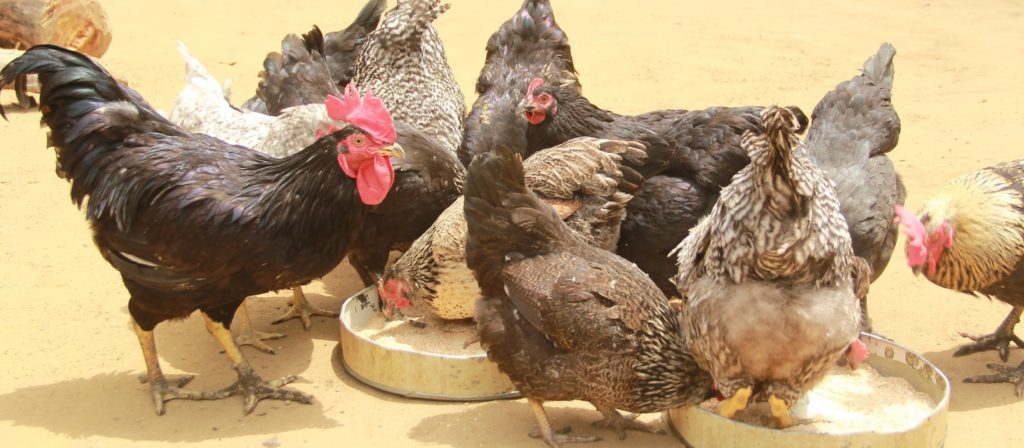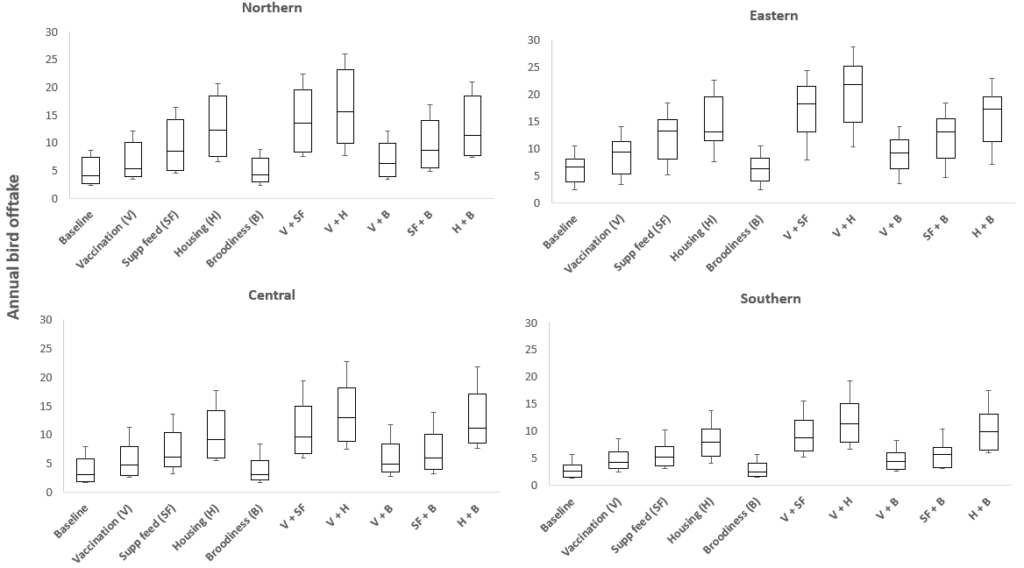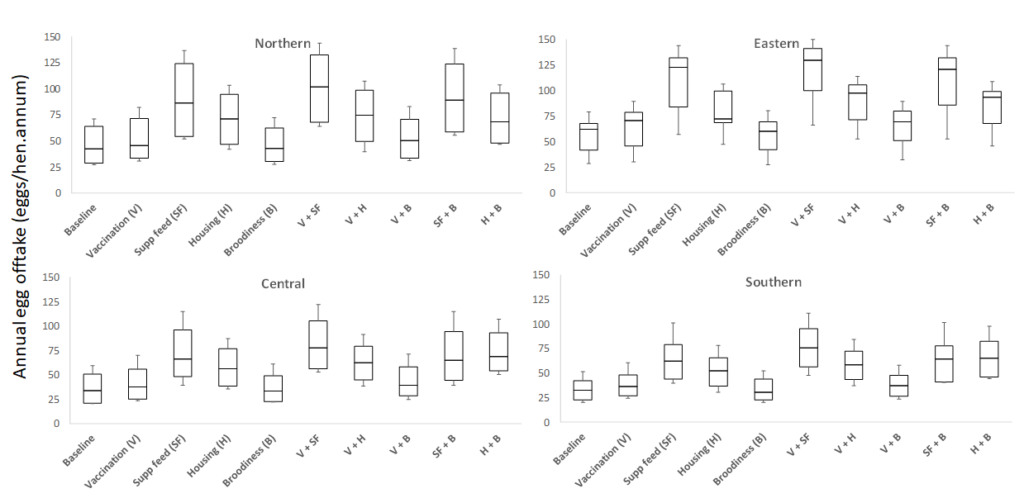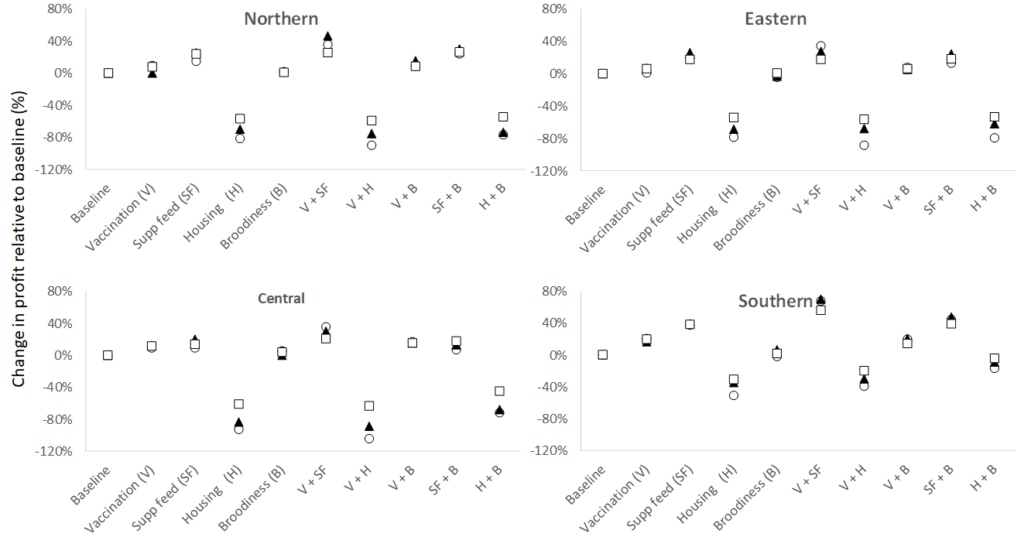Improving poultry production in Nigeria
Most chicken meat and eggs are produced in low input, low yielding systems with indigenous poultry. Chicken meat production can be increased by feeding additional supplements and providing daytime housing and improving health care.
FUNAAB Alpha birds belonging to one of the farmers in Isiokpo, Nigeria. Photo credit: ILRI/Stevie Mann.
Current production system
There are three distinct poultry production systems in Nigeria; intensive commercial poultry (large flocks of modern hybrids), extensive poultry (associated with household raising small flocks of indigenous birds) and semi-intensive (a blend of the other two). Indigenous poultry generally scavenge during the day and are housed at night to reduce losses from predation and theft. There is often very limited supplementary feeding. Egg production is generally low, resulting in lower egg and meat production.
Issues limiting chicken meat production
Low growth rates
Largely caused by inadequate nutrition. Access to supplementary feed is low, and is generally of poor quality.
Low production
Largely caused by inadequate nutrition and broodiness of low genetic potential indigenous birds.
High animal mortality
Largely caused by disease and predation through lack of daytime housing.
Modelled baseline
- Baseline indigenous flock size varied between 4-5 birds for the small flocks (10th percentile) through to 22-30 birds for the large flocks (90th percentile).
- Four regions of Nigeria modelled.
- Loss of birds to predation varied between flock class but remained consistent across regions.
- Loss of birds to disease varied between flock class and region.
- Loss of birds to unknown losses remained consistent between flock class and region.
Modelled interventions to increase production
Vaccination
All birds vaccinated against Newcastle disease to reduce disease losses.
Improved feeding management
Supplementary feeding to produce more eggs and reduce age of first lay.
Improved housing
Flock retained indoors during the day to reduce predation.
Control of broodiness
Implemented control measures to reduced broodiness, thus increase egg production.
Combined interventions
Dual combination of the above-mentioned four intervention options, with the exception of combining supplementary feeding with housing.
Interventions can increase production
Meat production
Median meat production (bird offtake as sum of birds consumed and sold) was 3-7 birds per annum for the baseline system. Most interventions increased meat production across all regions. Daytime housing produced the greatest increase in meat production across all regions. Median meat production increased to 8-13 birds per annum. In contrast, controlling broodiness resulted in marginal changes in meat production.
Newcastle disease vaccination combined with daytime housing (V + H) increased median meat production to 11-22 birds per annum (280% increase averaged across the four regions). Vaccination combined with supplementary feeding (V + SF), and control of broodiness combined with daytime housing both increased meat production by around 200%, when averaged across the four regions.
Annual bird offtake (consumed and sold) for the baseline and each intervention option across the four regions of Nigeria (box plots are 10th, 25th, 50th, 75th and 90th percentiles, reflecting the increase in flock size from small to large).
Egg production
Median egg production (egg offtake as sum of eggs consumed and sold) was 33-62 eggs/hen per annum for the baseline system. Most interventions increased egg production across all regions. Supplementary feeding produced the greatest increase in egg production across all regions. Median egg production increased to 62-122 eggs/hen per annum. Daytime housing also substantially increased egg production to 52-77 eggs/hen per annum. In contrast, controlling broodiness resulted in marginal changes in egg production.
Supplementary feeding combined with Newcastle disease vaccination (SF + V) increased median egg production to 76-129 eggs/hen per annum. Supplementary feeding and the control of broodiness (SF + B) also resulted in an almost doubling of egg production, to 64-121 eggs/hen per annum.
Annual egg offtake (consumed and sold) for the baseline and each intervention option across the four regions of Nigeria. Box plots are 10th, 25th, 50th, 75th and 90th percentile, reflecting the increase in flock size from small to large.
Profitability of interventions
The baseline median profit varied between regions and ranged between ~ NGN1 3,950 to NGN 7,500 per annum. Of the four individual intervention options, supplementary feeding was the most profitable across all four regions, as a result of the greatest increase in egg production. Median profits increased by 20-39%, relative to the baseline. While daytime housing resulted in the greatest increase in bird offtake, adopting this option showed negative impact on profitability, with median profits declining by between 34% and 83%.
Newcastle disease vaccination combined with supplementary feeding (V + SF) resulted in the greatest increase in profit across all four regions of Nigeria, increasing by between 28% and 70%, relative to their corresponding baseline profits.
Percentage change in profit, relative to the baseline, for each intervention option across the four regions of Nigeria. Small flocks (10th percentile) represented by a circle, median flocks (50th percentile) represented by triangle, large flocks (90th percentile farms) represented by a square.
11 USD ~ 367 Nigerian Naira (NGN)
Key messages
Bird and egg offtake increased with all intervention options, although there was minimal change when controlling broodiness.
Combined interventions can be more successful than single interventions.
Combining vaccination with daytime housing resulted in the greatest increase in meat production, and by a rate similar to the sum of each option as single intervention options.
Combining supplementary feeding with vaccination resulted in the greatest increase in egg production, and by a rate greater than the sum of each option as single intervention options.
As flock size increased from small (10th percentile) to large (90th percentile), the percentage increase in meat and egg production declined. This highlights greater benefit of implementing intervention options for small to medium producers.
Supplementary feeding was the most profitable single intervention option and was most profitable for the medium (50th percentile) flocks. In contrast, daytime housing was unprofitable in all regions, irrespective of flock size, due to additional costs of supplementary feeding and additional infrastructural costs.
Combining supplementary feeding with either vaccination or control of broodiness increased profitability the most across all regions. Therefore, there is merit in identifying ways in which households can obtain inexpensive supplementary feed to increase egg and bird offtake to improve profitability, especially for small to medium producers.
Download the Improving poultry meat production in Nigeria factsheet here.
Download the Improving poultry egg production in Nigeria factsheet here.




